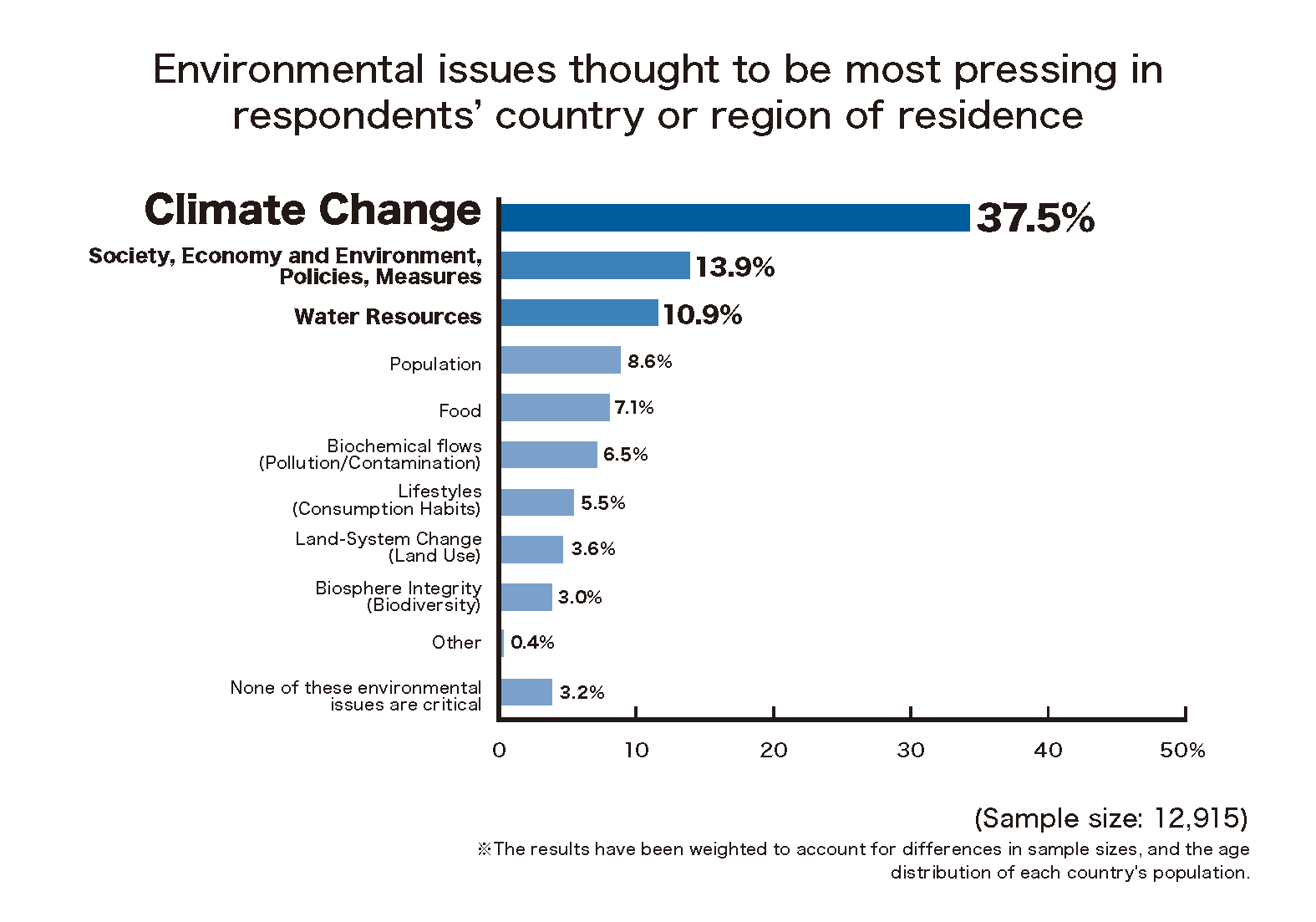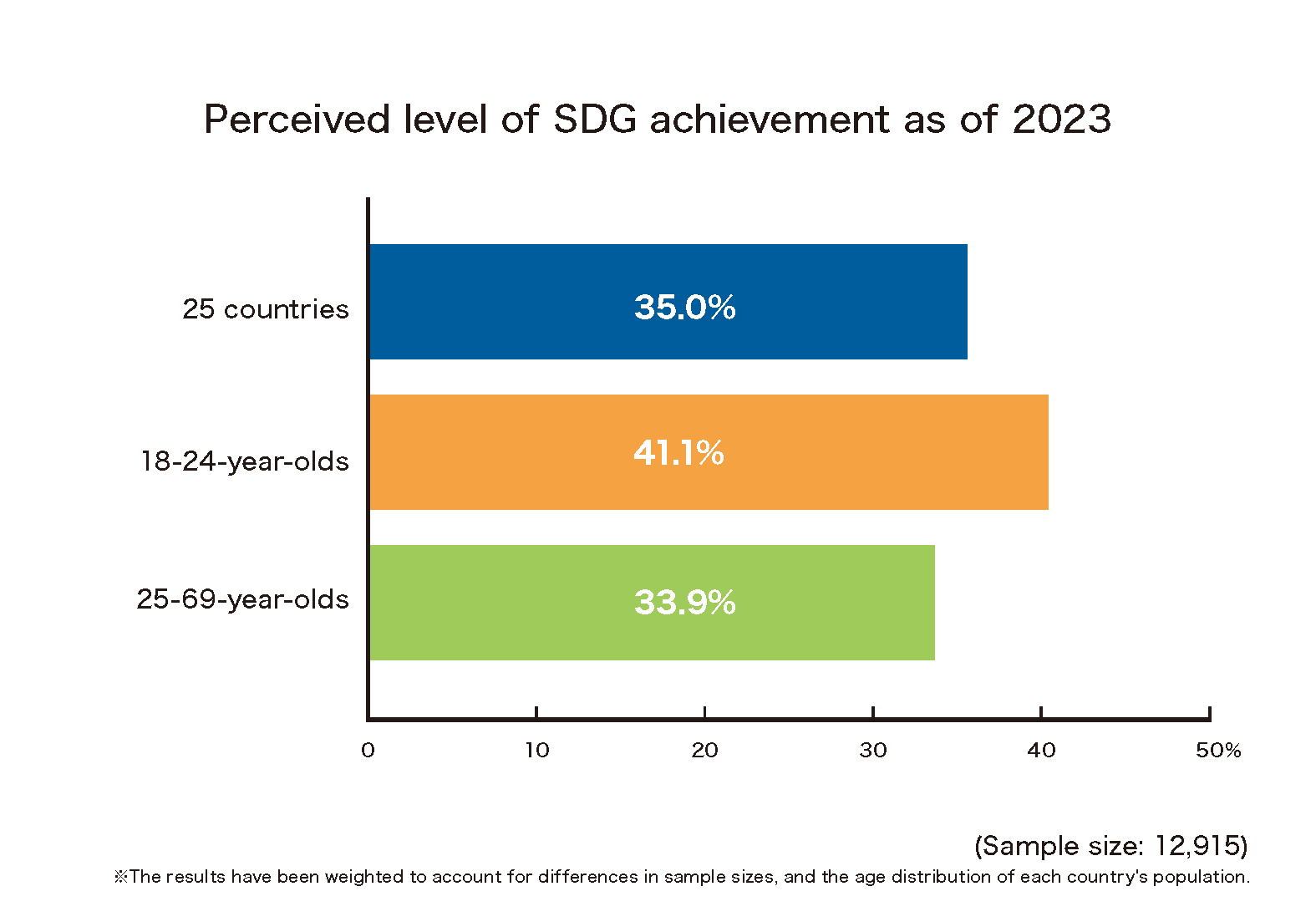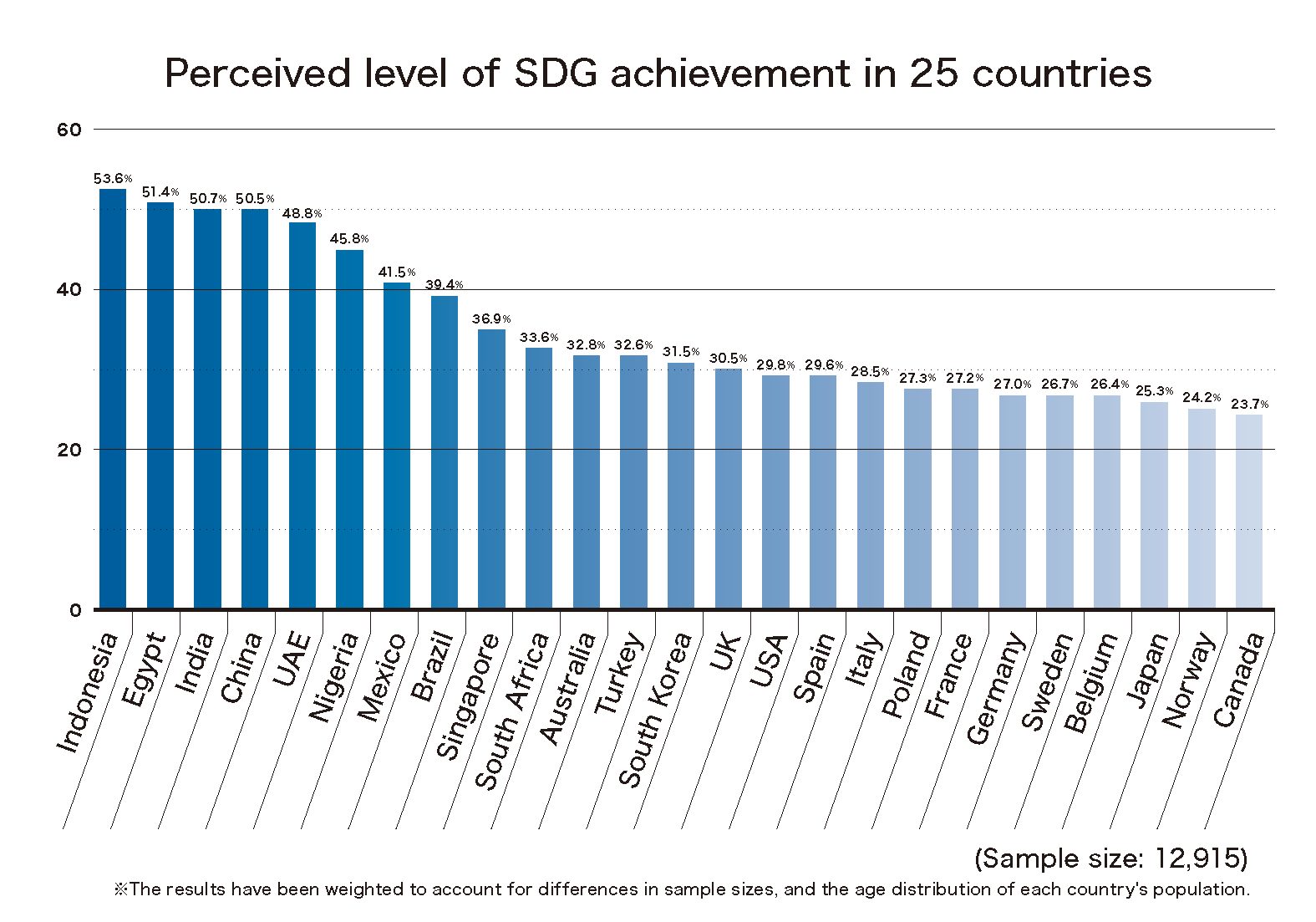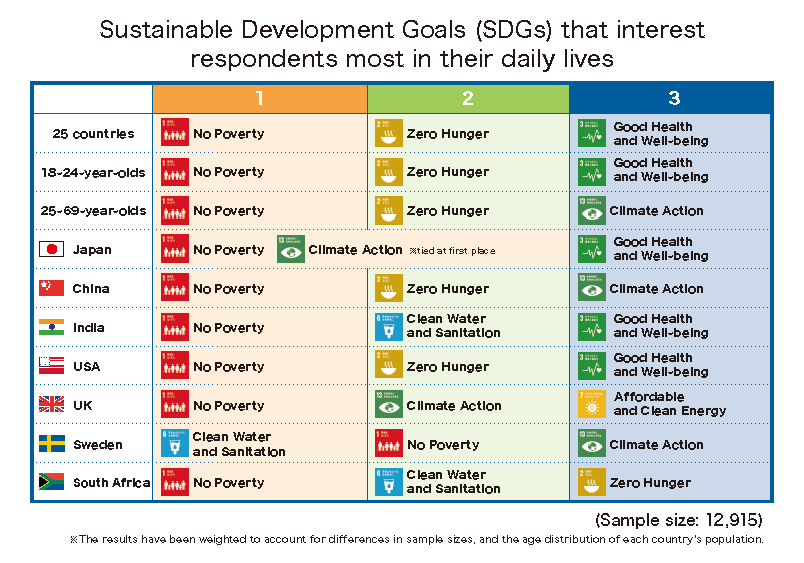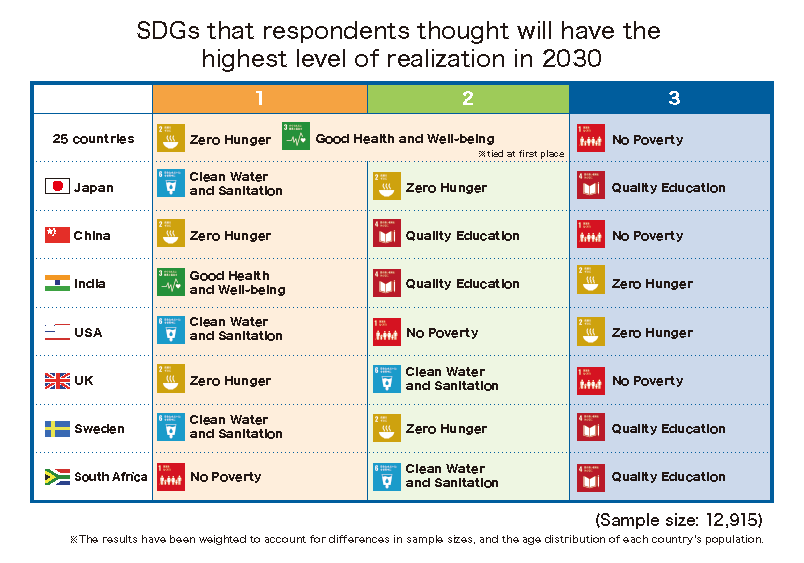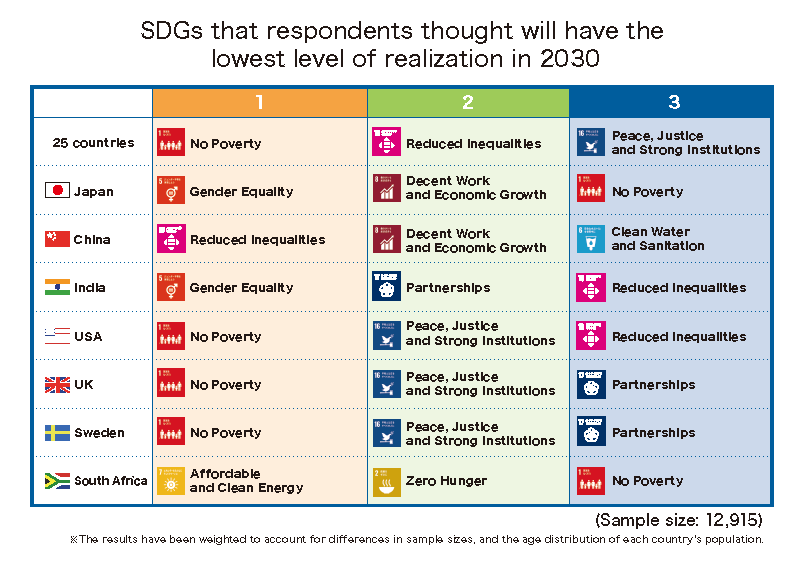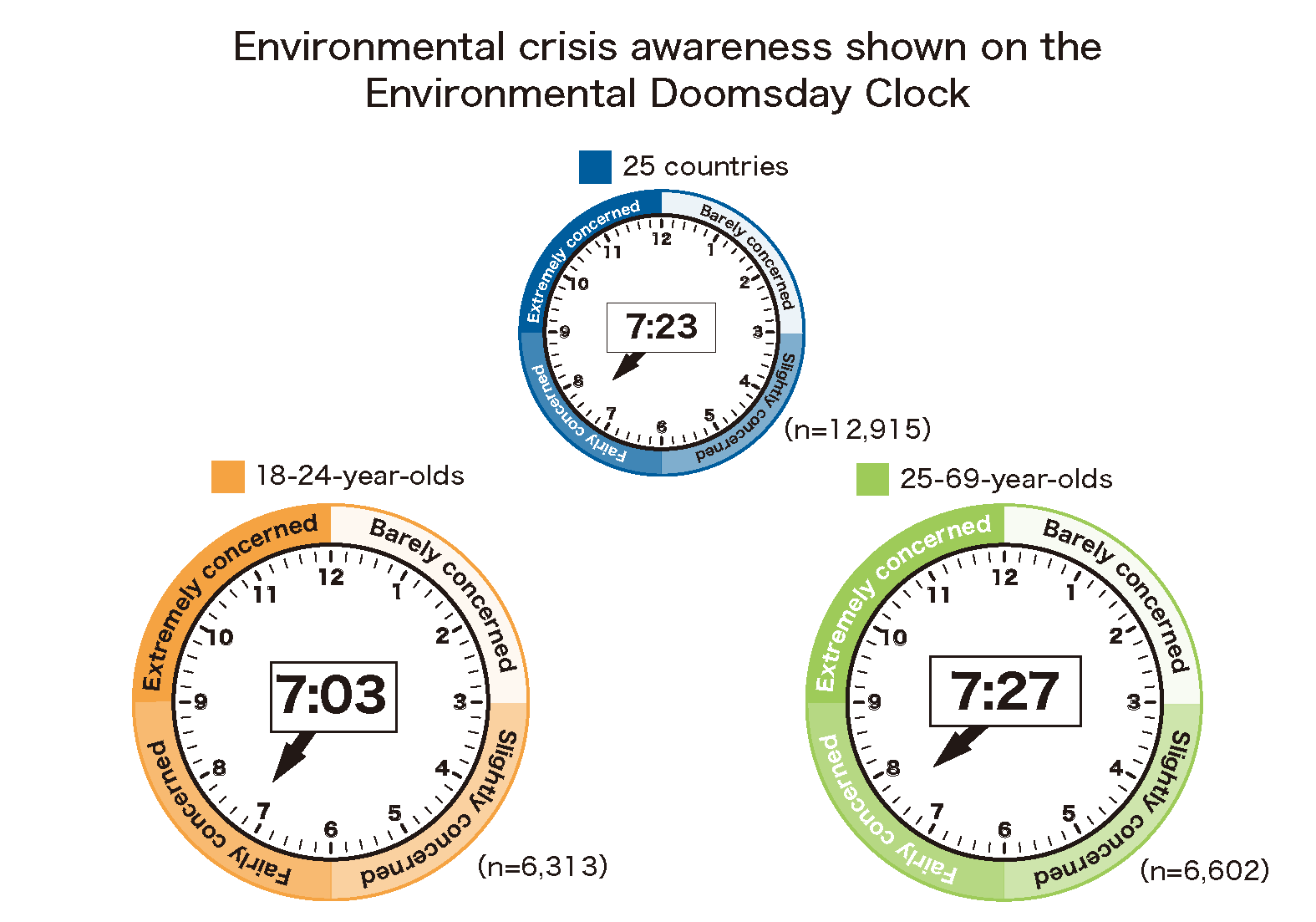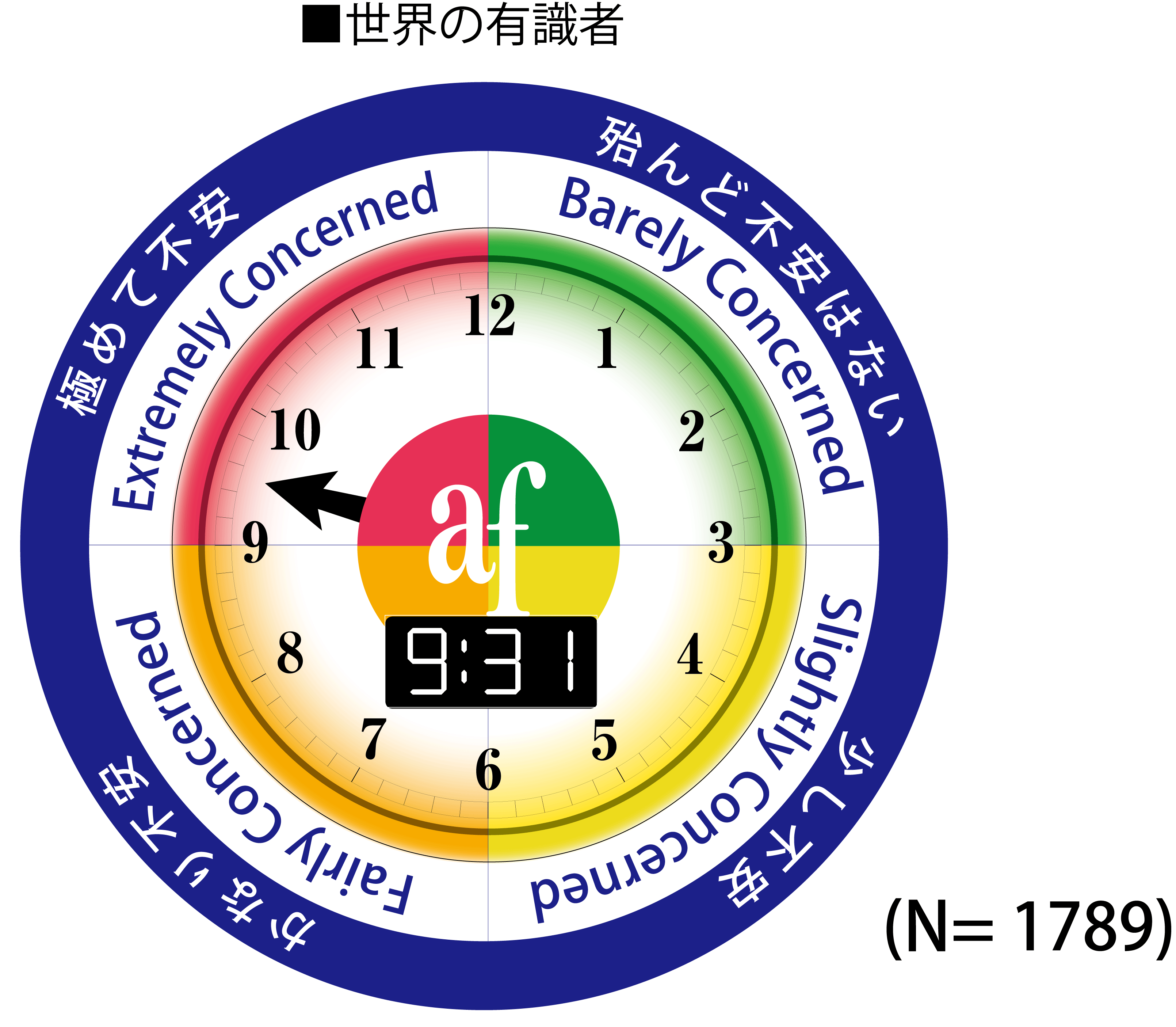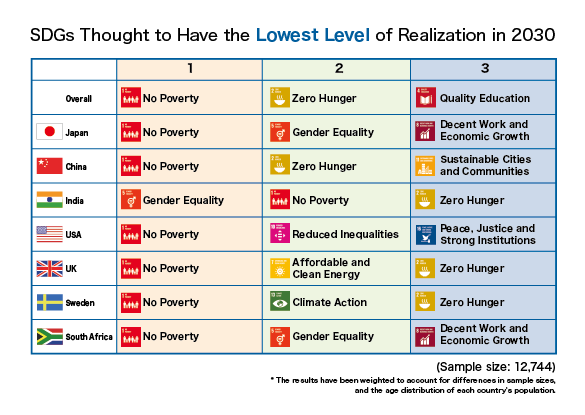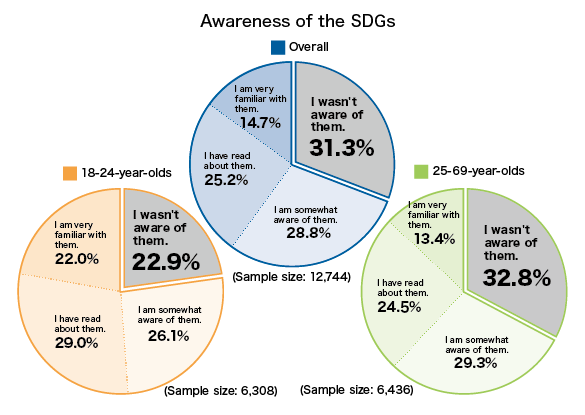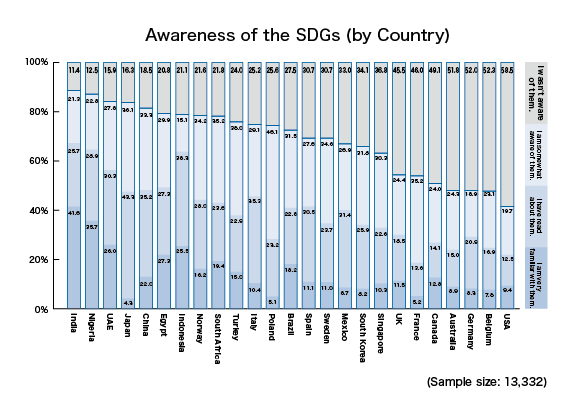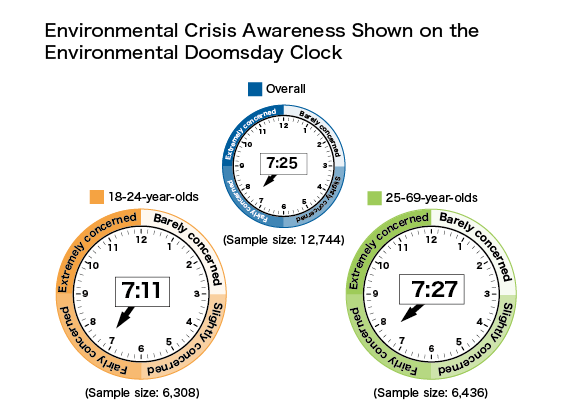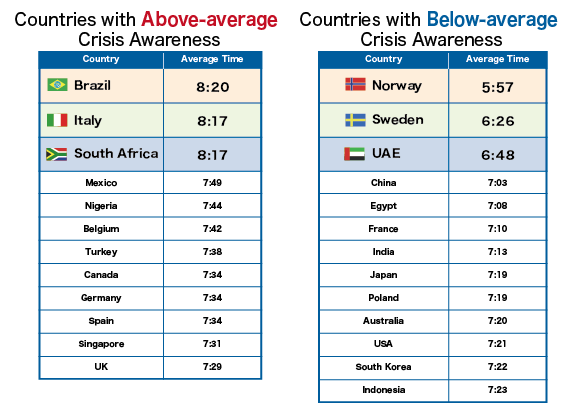The Environmental Doomsday Clock Survey on the Awareness of Environmental Issues Among the General Public
To understand the awareness and behavior of the general public towards environmental issues, we conducted a 'Survey on the Awareness of Environmental Issues Among the General Public.' The results of the survey are shown below.
Please note that all figures in this article can be enlarged by clicking on them.
2023.09.06Survey on the Awareness of Environmental Issues Among the General Public (in Japan and 24 other countries)
Climate change was rated as the top issue
As of 2023, the average perceived level of SDG achievement across all age groups was 35%. The average for 18-24-year-olds was 41%, slightly higher than the older generation.
Regarding the SDGs that participants thought will have the lowest level of realization, there was a global trend of expressing concerns about equality and peace.
The Asahi Glass Foundation, chaired by Takuya Shimamura, conducted an online survey of 13,500 people in Japan and 24 other countries in total, with 6,589 participants aged 18-24, and 6,911 participants aged 25-69. Its goal was to assess awareness and action regarding environmental issues. The survey was supervised by Professor Norichika Kanie of Keio University.
Its main findings were as follows:
- Overall, participants rated "Climate Change" as the most pressing environmental issue in the country or region where they reside and expressed concern over extreme weather conditions. This was followed by "Society, Economy and Environment, Policies, Measures," and "Water Resources."
- The participants chose Japan as the country that is making progress in terms of public awareness and action on environmental issues, followed by the USA and China. The reasons for choosing Japan included "the people are disciplined" and "it has excellent technology."
- As of 2023, the average perceived level of SDG achievement across all age groups was 35.0%. The average for 25-69-year-olds was 33.9%, while 18-24-year-olds was 41.1%, slightly higher than the older generation.
- Out of the 17 SDGs, "No Poverty" (1st), "Zero Hunger" (2nd), and "Good Health and Well-being" (3rd) were selected as the goals that interested participants most in their daily lives. "Climate Action" did not rank within the top 3.
- The Sustainable Development Goals (SDGs) that participants thought will have the highest level of realization by 2030 were "Zero Hunger" (1st), "Good Health and Wellbeing" (2nd), and "No Poverty" (3rd). The SDGs that participants thought would have the lowest level of realization were "No Poverty" (1st), "Reduced Inequalities" (2nd), and "Peace, Justice and Strong Institutions" (3rd). The percentage of people who were concerned about equality and peace was higher than last year, possibly due to the influence of the Russia-Ukraine conflict.
- When showing the time on the Environmental Doomsday Clock (environmental crisis awareness time), from 0:01 to 12:00, participants of all age brackets averaged out at 7:23, meaning "fairly concerned." 18-24-year-olds averaged out slightly lower at 7:03, while 25-69-year-olds were at 7:27, meaning they were slightly more concerned. The average time given by global environmental experts was two hours ahead of the general public, at 9:31, "extremely concerned." But both experts and the general public expressed a sense of crisis.
Survey overview
| Goal | To assess the general public's awareness and behavior regarding environmental issues |
|---|---|
| Participants | 13,500 people (18-24-year-olds: 6,589, 25-69-year-olds: 6,911) |
| Locations |
Japan, and 24 other countries (South Korea, China, Singapore, Indonesia, India, Australia, USA, Canada, Mexico, Brazil, UK, France, Germany, Italy, Spain, Belgium, Poland, Norway, Sweden, Turkey, UAE, Egypt, Nigeria, South Africa) |
| Method | Online research |
| Survey period | June 9th to July 5th, 2023 |
| Number of valid responses | 13,500 |
| Survey | carried out by the Asahi Glass Foundation |
-
※Questions 1, 4, 5 and 6, shown on the following pages, are taken from the "Questionnaire on Environmental Problems and the Survival of Humankind", a 2023 survey conducted among global environmental experts by the Asahi Glass Foundation. The questions have been simplified for the general public.
※The "Questionnaire on Environmental Problems and the Survival of Humankind" has been carried out annually since 1992. It assesses awareness of environmental issues among global environmental experts registered in the Asahi Glass Foundation's database, including those in national or local governments, NGOs NPOs, universities and research institutions, corporations, mass media, and so on, worldwide. Every year, the experts are asked to show their current sense of crisis regarding the environment and the survival of humankind, using the hands on the "Environmental Doomsday Clock."
Survey details
Overall, participants rated "Climate Change" as the most pressing environmental issue in the country or region where they reside and expressed concern over extreme weather conditions. This was followed by "Society, Economy and Environment, Policies, Measures," and then "Water Resources."
Q1.
Please select the three most pressing environmental issues from the list below, for the country or the region where you reside. Rank them in order of importance. Please give detailed reasons for your responses.
The issues listed are the same as those used in the "Questionnaire on Environmental Problems and the Survival of Humankind."
- As in the last year, the environmental issue most commonly rated as the most pressing was "Climate Change" (37.5%). Many participants expressed concern over the increasing frequency and severity of abnormal weather conditions and temperatures.
- The second and third most pressing issues were "Society, Economy and Environment, Policies, Measures" (13.9%), and then "Water Resources" (10.9%).
- "Climate Change" was also rated as the most pressing issue in this year's survey directed at global environmental experts, conducted by the Asahi Glass Foundation.
- A selection of the most common reasons given for each issue are listed below.
Some omissions have been made
<Climate Change>
"Unprecedented events like extreme heat and wildfires are occurring." (USA)
"Recent summers see new record high temperatures each year, and I sense that spring and fall have become shorter." (Japan)
"The drastic climate change affects livestock, withers crops, and leads to hunger." (South Africa)
<Society, Economy and Environment, Policies, Measures>
"The government doesn't prioritize environmental issues and lacks incentives for encouraging the purchase of environmentally friendly products." (UK)
" There should be strict laws and substantial fines for environmental law violators." (India)
" While there are several solutions to global climate issues, the most urgent problem is hunger." (Indonesia)
<Water Resources>
"We are not aware of our water consumption and are not engaging in water-saving activities." (Australia)"
""Droughts have occurred in many parts of the world, including my country, and the amount of water available is decreasing." (Sweden)"
""Water shortages are common in many retail stores, and the price of bottled water is increasing year by year." (China)"
The participants chose Japan as the country that is making progress in terms of public awareness and action on environmental issues, followed by the USA and China. The reasons for choosing Japan included "the people are disciplined" and "it has excellent technology."
Q2.
Please select three countries from the list below that you think are making progress in terms of public awareness and action on environmental issues, and rank them from 1st to 3rd. Please give detailed reasons for your responses.
The list consisted of the top 50 countries shown in the "2022 SDG Index & Dashboards," a by-country ranking of the progress made towards achieving the Sustainable Development Goals set forth by the United Nations.
- The list was drawn from the top 50 countries shown in the "2022 SDG Index & Dashboards," a by-country ranking of the progress made towards achieving the Sustainable Development Goals set forth by the United Nations.
- Overall, the countries thought to be making progress in terms of public awareness and action on environmental issues were Japan (1st), the USA (2nd) and China (3rd). In Indonesia and Turkey, there were many respondents who ranked Japan in first place, citing reasons such as "people are disciplined" and "there is excellent technology."
- Out of the 25 countries surveyed, excluding Indonesia, Turkey, Nigeria, Belgium, and Poland, respondents in 20 countries ranked their own country in first place.
- A selection of the most common reasons given for each issue are listed below.
Some omissions have been made. <Japan>
"Japan is known for its strong discipline and excellent technology." (Indonesia)
"Japanese people keep the environment clean in the places they visit and set an example for others." (Turkey)
"Surprisingly, many foreigners say that Japan has a good waste separation system." (Japan)
<USA>
"A country that has initiated movements for every issue related to global warming and climate change." (Indonesia)
"The most developed country in the world, possessing all resources and technology to overcome heat." (India)
"There are many companies that are working harder than anywhere else to be more environmentally friendly." (USA)
<China>
"Promoting clean energy, electric vehicles, and the planting of millions of trees." (Singapore)
"In a very short time, China transformed from one of the most polluted countries on Earth to one of the least polluted." (Spain)
"China Implemented regulations banning all activities that harm the environment and issued relevant laws." (China)
As of 2023, the average perceived level of SDG achievement across all age groups was 35.0%. The average for 25-69-year-olds was 33.9%, while 18-24-year-olds was 41.1%, slightly higher than the older generation.
Q3. Toward the goals for 2030, to what extent do you think the 17 SDGs as a whole will have been achieved as of 2023? Please provide a number from 1 to 100, assuming 100% means achieving all goals. If you don't think any particular initiatives are underway to achieve the goals, please enter "0 (zero)." The 17 Sustainable Development Goals (SDGs), adopted at a United Nations summit in September 2015, are an international plan to build a better, more sustainable world by 2030.
- As of 2023, the perceived level of SDG achievement varies from country to country, but the average of 25 countries was 35.0%. Developing countries tend to perceive higher levels of achievement.
- Among 25 countries, 10.8% of the respondents answered 0% for the perceived level of SDG achievement, indicating that approximately one-tenth of the respondents believe that there has been no SDG achievement at all.
- By generation, the average for 18-24-year-olds is 41.1%, while the average for 25-69-year-olds is 33.9%, indicating that the younger generation perceives a higher level of SDG achievement by 7.2 percentage points.
- By country, Indonesia showed the highest perceived level of SDG achievement with a rate of 53.6%, and Canada showed the lowest perceived level of SDG achievement with a rate of 23.7%.
Out of the 17 SDGs, "No Poverty" (1st), "Zero Hunger" (2nd), and "Good Health and Well-being" (3rd) were selected as the goals that interest participants most in their daily lives. "Climate Action" did not rank within the top 3.
Q4. Out of the 17 Sustainable Development Goals, please select three goals that interest you in your daily life, and rank them from 1st to 3rd. Please answer using the corresponding Sustainable Development Goal number.
- "No Poverty" (1st), "Zero Hunger" (2nd), and "Good Health and Well-being" (3rd) were selected as the goals that interested participants most in their daily lives. "Climate Action" did not rank within the top 3.
- Across generations, both 18-24-year-olds and 25-69-year-olds ranked "No Poverty" as first, followed by "Zero Hunger" in second place. However, there was a difference in the third place. Younger generation chose "Good Health and Well-being" while the older generation chose "Climate Action."
- On a country-by-country basis, there were variations in issues of interest, such as in Sweden, where "Clean Water and Sanitation" ranked first, and in the UK where "Climate Action" was in second place.
- In the 2023 Asahi Glass Foundation's survey directed at environmental experts, "Climate Action" ranked first, followed by "Good Health and Well-being" in second place.
The SDGs that participants thought will have the highest level of realization by 2030 were "Zero Hunger" (1st), "Good Health and Wellbeing" (1st), and "No Poverty" (3rd). The SDGs that participants thought will have the lowest level of realization were "No Poverty" (1st), "Reduced Inequalities" (2nd), and "Peace, Justice and Strong Institutions" (3rd). There was a global trend of expressing concerns about equality and peace, possibly influenced by the Russia-Ukraine war.
Q5. Out of the 17 Sustainable Development Goals, please select three goals that will have the highest/lowest level of realization in your country or region in 2030, and rank them from lowest (1st) to highest (3rd) level of realization. Please answer using the corresponding Sustainable Development Goal number.
- Regarding the SDGs that will have the highest level of realization by 2030, the survey results across 25 countries had "Zero Hunger" and "Good Health and Wellbeing," tied at first place followed by "No Poverty" in third place.
- This year's survey directed at global environmental experts, conducted by the Asahi Glass Foundation, shows that "Clean Water and Sanitation" will have the highest level of realization in respondents' own country or region.
- Regarding the SDGs that will have the lowest level of realization by 2030, the survey results across 25 countries show that "No Poverty" ranked first, followed by "Reduce Inequalities" in second place, and "Peace, Justice and Strong Institutions" in third place. There was a global trend of expressing concerns about equality and peace, possibly influenced by the Russia-Ukraine war.
- This year's survey directed at global environmental experts, conducted by the Asahi Glass Foundation, shows that "No Poverty" will have the lowest level of realization in respondents' own country or region.
- Overall, participants from 25 countries showed environmental crisis awareness at 7:23, meaning "fairly concerned." By age group, 18-24-year-olds averaged out at a slightly lower time of 7:03 and 25-69-year-olds averaged out at a later time of 7:27. Both age groups fell into the "fairly concerned" bracket.
- The time on the Environmental Doomsday Clock of the world moved back by 2 minutes. By country, in Japan, China, Italy, and Germany, the time moved back by more than 20 minutes, while in South Korea, the UK, and France, the time moved forward by more than 20 minutes.
- Although both global environmental experts and the general public expressed a sense of crisis, the time given by the experts was more than two hours ahead of the general public, at 9:31, "extremely concerned."
- Many respondents expressed feelings of anxiety due to their concerns about climate change, a phenomenon evident around the world.
-
A selection of other reasons is listed below.
Some omissions have been made.
"There is a prediction that if the current state continues, mass extinctions could occur by 2050; yet it appears that countries are doing very little to prevent the climate crisis." (USA)
"I believe humans have come to a point where they need to seriously contemplate what they should do for the Earth and take action; otherwise, we will reach a point of no return." (Japan)
"It may be too late to stop or mitigate the worsening of the problem, but many people feel that there is still time to turn things around." (Sweden)
When showing the time on the Environmental Doomsday Clock (environmental crisis awareness time), from 0:01 to 12:00, participants averaged out at 7:23, meaning "fairly concerned." 18-24-year-olds averaged out slightly lower at 7:03, while 25-69-year-olds were at 7:27, meaning they were slightly more concerned.
The average time given by global environmental experts was more than two hours ahead of the general public, at 9:31, "extremely concerned." Both experts and the general public expressed a sense of crisis.
Q6. The following figure shows the Environmental Doomsday Clock which, by the position of the hands on the clock, shows the perceived degree of crisis towards environmental issues. Please indicate your sense of crisis toward environmental issues in your country or region by using hours and minutes between 0:01 and 12:00, e.g. "HH:MM." For the purpose of calculating results, please select your times in units no smaller than 10 minutes.
Remarks from the Survey's Supervisor
This survey, which was conducted overseas and in Japan, was the second of its kind, and it reveals intriguing results.
Globally, this summer has seen an escalation in extreme weather patterns, and wildfires attributed to climate change have been frequently reported. As the UN Secretary-General Antonio Guterres termed it "global boiling," the impact of climate change is becoming obvious around the world. This is clearly reflected in the results of this survey. Respondents are most concerned about climate change, recognizing it as a pressing problem.
Research into environmental issues has highlighted progress in European countries, particularly in Northern European countries. In contrast, countries like the United States and Japan have faced criticism for lagging behind in their environmental initiatives. This trend is especially noticeable in the context of climate change.
In contrast, in response to Question 2, participants ranked Japan and the United States higher than other countries in terms of peoples' awareness and actions on environmental issues. This is probably because the questions focused on how the respondents perceive environmental technology, products, and behavior, rather than their opinions on government policies and measures. In the United States, while federal policies are poor, there is progress at the level of specific companies and states. It seems that the respondents are significantly influenced by the caliber of such "good examples." Moreover, it might also be influenced by the way the media portrays these efforts.
As of mid-2023, according to United Nation' s surveys, the level of achievement of the Sustainable Development Goals (SDGs) remains below 20%. Climate crisis, the COVID-19 pandemic, and the devastation of the war are recognized as major factors that caused stagnation or regression. In comparison to this actual progress level, people's awareness tends to overstate the level of achievement. Particularly in Japan, around 90% of the population is aware of the SDGs, influenced in part by the buzz surrounding the concept. However, it's important to acknowledge that the reality is quite different; significant progress in people's behavior has yet to be observed.gap.
Having a sense of crisis is an important first step toward taking action. To cultivate a sense of urgency that is in line with reality, so we need to consider our future actions.
Profile of the Survey's Supervisor

Norichika Kanie
Professor, Graduate School of Media and Governance, Keio University
Kanie is also the director of the xSDG Laboratory, within the Keio Research Institute at SFC. Before joining Keio, he worked at the Tokyo Institute of Technology's Graduate School of
Decision Science and Technology, and the University of Kitakyushu's Department of Policy Studies.
Kanie serves on various committees and steering groups. He is a member of the SDGs Promotion Roundtable Meeting, established by the Japanese government under the SDGs Promotion
Headquarters; he is a member of the Expert Study Group for the Promotion of SDGs by Local Governments for the Japanese Cabinet Office; and for four years from 2017 he was an External
Director at RENOVA Inc.
Kanie's research focuses on International Relations, Sustainability Science and Earth System Governance. He participated in the formulation of the Sustainable Development Goals (SDGs),
the common goals adopted by the United Nations, from the conception stage. He is a leading authority on the SDGs, and is striving to balance research and practice. He recently published
"SDGs (Sustainable Development Goals)" (Chukoshinsho, 2020), and has been selected as one of 15 independent scientists that will draft the second quadrennial Global Sustainable
Development Report. Kanie received his Ph.D. in Media and Governance from Keio University.
2022.09.08Survey on the Awareness of Environmental Issues Among the General Public (in Japan and 24 other countries)
Climate change was rated as the top issue
The Asahi Glass Foundation, chaired by Takuya Shimamura, conducted an online survey of 13,332 people in Japan and 24 other countries in total, with 6,585 participants aged 18-24, and
6,747 participants aged 25-69. Its goal was to assess awareness and action regarding environmental issues. The survey was supervised by Professor Norichika Kanie, of Keio University. Its
main findings were as follows:
- Overall, participants rated "Climate Change" as the most pressing environmental issue in the country or region where they reside and expressed concern over abnormal weather conditions. The number two issue was "Society, Economy and Environment, Policies, Measures," and the number three issue was "Water Resources."
- Participants rated Japan, the USA and Australia as the top three countries making progress in terms of public awareness and action on environmental issues.The reasons given for selecting Japan included "cutting-edge technology" and "cleanliness."
- The Sustainable Development Goals that participants thought will have the highest level of realization by 2030 were "No Poverty" (1st), "Good Health and Wellbeing" (2nd), and "Zero Hunger" (3rd). The SDGs that participants thought would have the lowest level of realization were "No Poverty" (1st), "Zero Hunger" (2nd), and "Quality Education" (3rd). Opinions were split on whether poverty can be eradicated, even among people from the same country, with developed nations giving more pessimistic answers.
- Around 30% of participants hadn't heard of the SDGs. 18-24-year-olds had a slightly higher awareness than 25-69-year-olds.
- When showing environmental crisis awareness time on a clock, from 0:01 to 12:00, participants of all age brackets averaged out at 7:25, meaning "fairly concerned." 18-24-year-olds averaged out slightly lower at 7:11, while 25-69-year-olds were at 7:27, meaning they were slightly more concerned. The average time given by global environmental experts was two hours ahead of the general public, at 9:35, "extremely concerned." But both experts and the general public expressed a sense of crisis.
Survey overview
| Goal | To assess the general public's awareness and behavior regarding environmental issues |
|---|---|
| Participants | 13,332 people (18-24-year-olds: 6,585, 25-69-year-olds: 6,747) |
| Locations |
Japan, and 24 other countries (South Korea, China, Singapore, Indonesia, India, Australia, USA, Canada, Mexico, Brazil, UK, France, Germany, Italy, Spain, Belgium, Poland, Norway, Sweden, Turkey, UAE, Egypt, Nigeria, South Africa) |
| Method | Online research |
| Survey period | June 23rd to July 18th, 2022 |
| Number of valid responses | 13,332 |
| Survey | carried out by the Asahi Glass Foundation |
-
※Questions 1, 3 and 5, shown on the following pages, are taken from the "Questionnaire on Environmental Problems and the Survival of Humankind", a 2022 survey conducted among global
environmental experts by the Asahi Glass Foundation. The questions have been simplified for the general public.
※The "Questionnaire on Environmental Problems and the Survival of Humankind" has been carried out annually since 1992. It assesses awareness of environmental issues among global environmental experts registered in the Asahi Glass Foundation's database, including those in national or local governments, NGOs NPOs, universities and research institutions, corporations, mass media, and so on, worldwide. Every year, the experts are asked to show their current sense of crisis regarding the environment and the survival of humankind, using the hands on the "Environmental Doomsday Clock."
Survey details
Overall, participants rated "Climate Change" as the most pressing environmental issue in the country or region where they reside and expressed concern over abnormal weather
conditions.
The number two issue was "Society, Economy and Environment, Policies, Measures," and the number three issue was "Water Resources."
Q1.
Please select the three most pressing environmental issues from the list below, for the country or the region where you reside. Rank them in order of importance. Please give detailed
reasons for your responses.
The issues listed are the same as those used in the "Questionnaire on Environmental Problems and the Survival of Humankind."
- Overall, the environmental issue most commonly rated as the most pressing was "Climate Change" (36.3%). Many participants expressed concern over the increasing frequency and severity of abnormal weather conditions and temperatures.
- The second and third most pressing issues were "Society, Economy and Environment, Policies, Measures" (14.4%), and "Water Resources" (11.2%).
- "Climate Change" was also rated as the most pressing issue in this year's survey of global environmental experts, conducted by the Asahi Glass Foundation.
-
The most common reasons given for each issue are listed below.
Some omissions have been made
<Climate Change>
"Recently, natural disasters have been more frequent and more severe."
"Climate change is affecting many different aspects of our lives."
"Climate change is driving many animal species to extinction."
<Society, Economy and Environment, Policies, Measures>
"I have a lot of reservations about how the authorities dealt with the COVID-19 pandemic."
"We need to strike a balance between social benefits, economic growth, and environmental policies."
"Education, and the passing on of knowledge to the next generation, act as the foundation of a sustainable society."
<Water Resources>
"Water is the world's most important resource."
"Many countries are already experiencing a water shortage, due to deforestation, pollution and other factors."
"In developing countries, securing access to clean water is a matter of life and death."
The reasons given for selecting Japan included "cutting-edge technology" and "cleanliness."
Q2.
Please select three countries from the list below that you think are making progress in terms of public awareness and action on environmental issues, and rank them from 1st to 3rd. Please
give detailed reasons for your responses.
The list consisted of the top 50 countries shown in the "2022 SDG Index & Dashboards," a by-country ranking of the progress made towards achieving the Sustainable Development Goals set
forth by the United Nations.
- Overall, the countries thought to be making progress in terms of public awareness and action on environmental issues were Japan (1st), the USA (2nd) and Australia (3rd). Participants in developing countries such as Indonesia, Egypt and China tended to put Japan in first position. Common reasons given included "cutting-edge technology" and "cleanliness."
- Among the 25 countries in which this survey was carried out, 14 were in the top 50 countries shown in the "2022 SDG Index & Dashboards" (South Korea, Japan, Australia, USA, Canada, UK, France, Germany, Italy, Spain, Belgium, Poland, Norway and Sweden). 13 of those countries put themselves in the top position, with Spain being the only exception.
-
The most common reasons given for each country are listed below.
Some omissions have been made. <Japan>
"Japan has cutting-edge technology in such fields as recycling and waste disposal."
"Japan humbly follows the rules, and tackles environmental issues."
"The streets are free of garbage, and people take care to sort their garbage."
<USA>
"As a global superpower, the USA has the knowledge and technology to spread awareness."
"There seem to be a lot of protests, demos and campaigns in the US."
"People in the US are encouraged to be more aware of environmental issues, and to take action."
<Australia>
"Australia proactively preserves mangrove forests, protects wild animals such as koalas, and so on."
"It is implementing many policies in response to forest fires."
"Many of its products are organic, or are designed with sustainability in mind."
The Sustainable Development Goals that participants thought will have the highest level of realization by 2030 were "No Poverty" (1st), "Good Health and Wellbeing" (2nd), and "Zero Hunger" (3rd). The SDGs that participants thought would have the lowest level of realization were "No Poverty" (1st), "Zero Hunger" (2nd), and "Quality Education" (3rd). Opinions were split on whether poverty can be eradicated, even among people from the same country, with developed nations giving more pessimistic answers.
Q3. Out of the 17 Sustainable Development Goals, please select three goals that will have the highest (or lowest) level of realization in your country or region in 2030, and rank them from first to third. Please answer using the corresponding Sustainable Development Goal numbers. The 17 Sustainable Development Goals (SDGs), adopted at a United Nations summit in September 2015, are an international plan to build a better, more sustainable world by 2030.
- Overall, the SDGs expected to have the highest level of realization by 2030 were "1. No Poverty" (1st), "3. Good Health and Wellbeing" (2nd) and "2. Zero Hunger" (3rd).
- In this year's survey of global environmental experts, conducted by the Asahi Glass Foundation, the SDG that was predicted to have the highest level of realization in each participant's country or region by 2030 was "6. Clean Water and Sanitation."
- Overall, the SDGs expected to have the lowest level of realization by 2030 were "1. No Poverty" (1st), "2. Zero Hunger " (2nd) and "4. Quality Education" (3rd). As for "1. No Poverty," people's expectations varied widely, even among those from the same country. Participants in developed nations such as the USA, France, Belgium and Norway tended to be more pessimistic, while those in developing nations, such as Indonesia, India and Egypt, tended to be more optimistic.
Around 30% of participants hadn't heard of the SDGs, though 18-24-year-olds had a slightly higher awareness than 25-69-year-olds.
Q4. Had you ever heard of the Sustainable Development Goals (SDGs) before answering Question 3?
- On average, 14.7% of participants answered " I am very familiar with them." 25.2% answered "I have read about them," 28.8% answered "I am somewhat aware of them," and 31.3% answered "I wasn't aware of them."
- 22.0% of 18-24-year-olds answered "I am very familiar with them," which was 8.6 percentage points higher than 25-69-year-olds at 13.4%. 22.9% of 18-24-year-olds answered "I wasn't aware of them," which was 9.9 percentage points lower than 25-69-year-olds at 32.8%.
- India displayed the highest level of awareness, with only 11.4% of participants answering "I wasn't aware of them." The USA displayed the lowest level of awareness, with 58.5% of participants giving that answer.
When showing environmental crisis awareness time on a clock, from 0:01 to 12:00, participants averaged out at 7:25, meaning "fairly concerned." 18-24-year-olds averaged out slightly
lower at 7:11, while 25-69-year-olds were at 7:27, meaning they were slightly more concerned.
The average time given by global environmental experts was two hours ahead of the general public, at 9:35, "extremely concerned." Both experts and the general public expressed a sense of
crisis.
Q5. The following figure shows the Environmental Doomsday Clock which, by the position of the hands on the clock, shows the perceived degree of crisis towards environmental issues. Please indicate your sense of crisis toward environmental issues in your country or region by using hours and minutes between 0:01 and 12:00, e.g. "HH:MM." For the purpose of calculating results, please select your times in units no smaller than 10 minutes.
- Overall, participants showed environmental crisis awareness at 7:25, meaning "fairly concerned." 18-24-year-olds averaged out slightly lower at 7:11. 25-69-year-olds averaged out at a later time 7:27. Both age groups fell into the "fairly concerned" bracket.
- In this year's survey of global environmental experts, conducted by the Asahi Glass Foundation, the average time was 9:35, meaning "extremely concerned." That's around two hours later than the time given by the general public.
- The most common reason given was concern about abnormal weather conditions and temperatures in all countries and regions.
-
Other reasons are listed below.
Some omissions have been made.
"Natural disasters keep happening, one after another."
"I'm worried about what the world will be like when today's kids grow up."
"So many things feel out of our control."
"We're at point where any action we take seems too late."
"The world is under a lot of pressure from factors such as climate change, overpopulation, and a shortage of food and resources."
Remarks from the Survey's Supervisor
This time, the survey was conducted both in and outside of Japan. It was a very interesting set of results, as it allows us to see the differences in opinion between Japan and other countries, as well as global awareness of environmental issues.
All around the world, climate change is seen as a critical environmental issue. I believe that viewing this alongside socioeconomic issues highlights the problems faced by modern society. It's important that environmental issues are increasingly seen as social and economic issues too. Climate change is a global problem, and there's a pressing need to strengthen our response. We can see a growing awareness of that fact.
I was a little surprised to see countries like Japan and the USA put forward as nations making progress on awareness and action regarding environmental issues. Many studies have concluded that European countries are further ahead. So there's a gap between fact and opinion. I'd like to see Japan and the USA implement proactive measures in order to catch up with their image.
In Japan, awareness of the SDGs is higher than many other countries, but the percentage of people who said they were "very familiar" was among the lowest of countries surveyed. I think we should really pay attention to that finding. It shows a strong need for measures that don't simply address the SDGs in a superficial way.
Both in Japan and abroad, "No Poverty" was the SDG expected to have the highest level of realization, and the lowest. It was rated the first in both categories, which shows just how
difficult solving that problem is likely to be. It's said that global inequality is growing, and differences of opinion are widening. This finding is a good illustration of that point.
Following the advent of COVID-19, there is also said to be a widening gap between those who grew poorer, and were left behind, versus those who benefitted economically from the pandemic. And
that trend seems to be influencing people's viewpoints. I believe that this survey shows how important it is to close the gap.
The hands of the Environmental Doomsday Clock have moved forward significantly since last year. And I hope that we can turn our awareness of the crisis into concrete action.
Profile of the Survey's Supervisor

Norichika Kanie
Professor, Graduate School of Media and Governance, Keio University
Kanie is also the director of the xSDG Laboratory, within the Keio Research Institute at SFC. Before joining Keio, he worked at the Tokyo Institute of Technology's Graduate School of
Decision Science and Technology, and the University of Kitakyushu's Department of Policy Studies.
Kanie serves on various committees and steering groups. He is a member of the SDGs Promotion Roundtable Meeting, established by the Japanese government under the SDGs Promotion
Headquarters; he is a member of the Expert Study Group for the Promotion of SDGs by Local Governments for the Japanese Cabinet Office; and for four years from 2017 he was an External
Director at RENOVA Inc.
Kanie's research focuses on International Relations, Sustainability Science and Earth System Governance. He participated in the formulation of the Sustainable Development Goals (SDGs),
the common goals adopted by the United Nations, from the conception stage. He is a leading authority on the SDGs, and is striving to balance research and practice. He recently published
"SDGs (Sustainable Development Goals)" (Chukoshinsho, 2020), and has been selected as one of 15 independent scientists that will draft the second quadrennial Global Sustainable
Development Report. Kanie received his Ph.D. in Media and Governance from Keio University.


